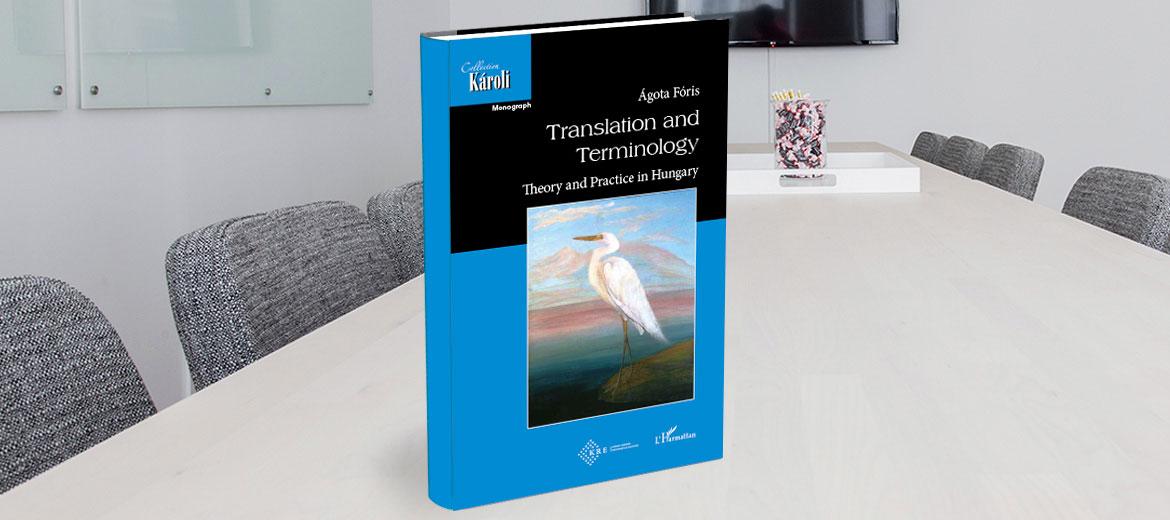
Translation and Terminology. Theory and Practice in Hungary
Author: Ágota Fóris
Károli Gáspár University of the Reformed Church in Hungary. L’Harmattan Publishing • Éditions L’Harmattan, Budapest–Paris, 2022. 210 p. ISBN 978-2-14-020931-4
Reviewers: Andrea Bölcskei, Dóra-Mária Tamás
Translator: Eszter B. Papp
Proofreader: Peter Sabath
www.harmattan.hu, www.amazon.fr
This book discusses the relationship between translation and terminology as well as theory and practice in the context of research and expertise. In recent years, the translation industry has undergone major changes: the volume of texts to be translated has increased dramatically and the use of computer-assisted translation tools has become a basic requirement. This trend has also led to the introduction of quality assurance processes at translation agencies, the requirement to use computer-assisted translation tools, the creation of terminology databases and an increase in the number of agencies now employing terminologists. For translators, learning to use new tools and methods and to solve terminological problems both in the analysis of the source text and in the production of the target text has become essential.
In addition to reviewing and describing the relationship between translation and terminology, this book aims to explain the basic concepts, and to explore the role of terminology and terminology databases in the translation process.
Contents:
Preface (by Henrik Nilsson); 9
Introduction; 13
On Terminology; 15
The environment of terminology; 15
Terminology and linguistics; 18
The terminological approach and the terminological system; 23
Term and terminology; 28
The term; 28
Nomenclature; 31
Terminology, terminology science and terminology management; 34
What does terminology do?; 38
Terminology schools and various trends in terminology; 40
Scientific and technical documentation; 42
Summary; 45
Translation and Terminology; 47
Translation studies and terminology science; 49
Publications and higher education; 54
Term usage; 54
Terminography – translation-oriented termbases; 56
Teaching of terminology in translator training; 57
Teaching of translation in terminology training; 66
Translator’s questions; 69
How can the translator recognize a term?; 69
What are some typical issues when translating terms?; 72
To translate or to find equivalents?; 74
Where to look for equivalence of terms in the source language?; 76
Equivalence in translation; 78
Methods and principles of term formation; 84
Terminology in the translation project process; 87
Translation-oriented terminography; 94
Summary; 104
Terminology as Information and Knowledge Management for Translators; 105
Historical background; 105
The emergence of terminology as a discipline in standardization; 109
International organizations and their Hungarian members; 115
Infoterm; 115
TermNet; 117
European Association for Terminology (EAFT); 119
Linguistic paradigm shift in terminology and translation studies; 120
Wüsterian approach to terminology; 121
The linguistic-communicative approach to terminology; 122
The sociocognitive theory of terminology; 124
An ontology-based approach to terminology; 125
Summary; 129
The Role of Terminology in Scientific Communication: The Terminology of Lasers; 131
The terminology of lasers: a historical overview; 131
A brief history of the laser; 132
Hungarian language terminology of lasers; 134
The meaning of the term lézer: steps of defining meaning; 138
The ELI project: high-energy atto- and femtosecond pulsed lasers; 142
Creating the termbase and dictionary for lasers; 145
Working methods, corpus and recording data; 146
A dictionary on laser terminology: the DictionELI; 150
Comments and examples; 151
Summary; 153
Scale-Free Network Theory in Translation; 155
Introduction: models of translation and terminology; 155
Models in research; 156
Main features of scale-free networks; 158
The network structure of language; 160
Models used in studying translation; 165
A scale-free network model of the terminological unit and trans; 170
A scale-free model of translating the terminological unit; 171
The scale-free network model of translation; 174
Summary; 176
Works Cited; 179
Sources; 205
Standards; 209
Appendix; 210

